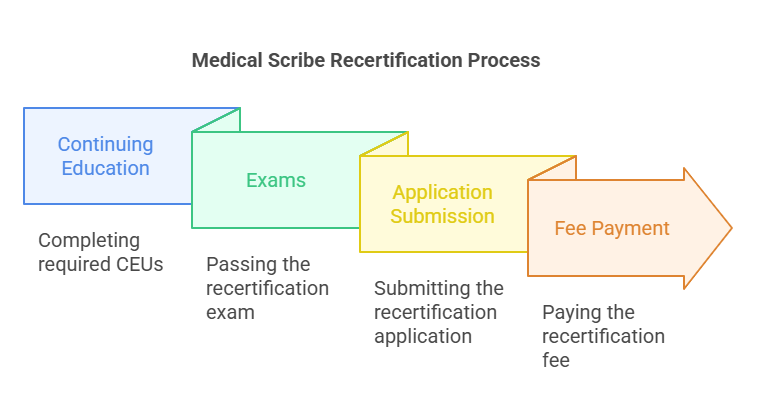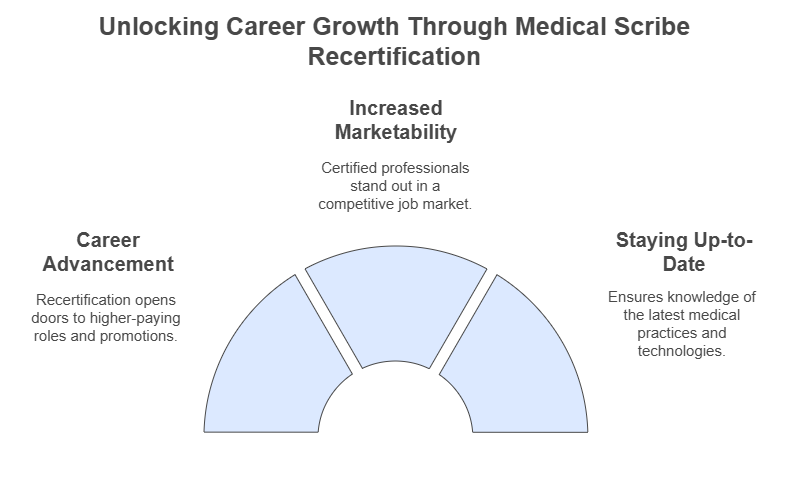Medical Scribe Certification Renewal: How Often Do You Need to Recertify?
Becoming a certified medical scribe is a significant achievement for individuals aspiring to work in healthcare environments. It enhances career opportunities and opens doors to various positions within hospitals, clinics, and private practices. However, like most certifications, medical scribe certifications require periodic renewal. If you're wondering how often you need to recertify, what the process involves, and what you need to know for 2025, this blog post will cover all these aspects in detail.
What is a Medical Scribe Certification?
A medical scribe is a trained professional who helps healthcare providers by documenting patient encounters in real-time, ensuring accurate, up-to-date medical records. Medical scribe certification verifies that an individual has undergone the necessary training and possesses the skills required to perform these duties effectively.
There are various medical scribe certification programs available, each offering different credentials. The most widely recognized certifications are provided by organizations like the American Health Information Management Association (AHIMA), American Academy of Professional Coders (AAPC), and The American Medical Scribe Association (AMSA).
Why is Medical Scribe Certification Important?
Having a certification validates your expertise and allows you to stand out in a competitive job market. It provides employers with confidence in your abilities, ensuring that you can contribute effectively to patient care by managing health records and assisting medical professionals. Additionally, certification may lead to higher pay, career growth, and more job stability.
For 2025 and beyond, the healthcare industry continues to evolve, and the demand for medical scribes is expected to increase. By obtaining and renewing your certification, you ensure that you remain qualified and competitive in the job market.
How Often Do You Need to Recertify?
The frequency of medical scribe certification renewal depends on the certifying body and the specific certification you hold. While most organizations require recertification every 2 years, some certifications may have different timelines. For instance, certain certifications may require recertification sooner, while others might have longer validity periods. Below is an overview of the recertification requirements for some of the major certifying bodies:
The American Medical Scribe Association (AMSA): AMSA's Certified Medical Scribe Professional (CMSP) certification is valid for 2 years. To renew, you must complete continuing education credits and successfully pass a recertification exam, ensuring that your knowledge stays up to date.
The American Health Information Management Association (AHIMA): The Certified Medical Scribe Specialist (CMSS) credential offered by AHIMA requires renewal every 2 years. To maintain your certification, you must accumulate 20 Continuing Education Units (CEUs), which help ensure you are up to date with medical terminology and current best practices.
The American Academy of Professional Coders (AAPC): The Certified Scribe Specialist (CSS) certification from AAPC also requires recertification every 2 years. You need to earn 20 CEUs and maintain active membership with AAPC to keep your certification current.
The Recertification Process
The recertification process for medical scribes ensures that professionals stay updated with the latest practices, tools, and regulations in the healthcare field. While the specifics of the process can vary depending on the certifying body, the general steps typically include the following:
Continuing Education (CEUs)
Most certifying organizations require medical scribes to complete a set number of continuing education hours as part of the recertification process. These hours are generally focused on key topics such as new medical terminology, updates in healthcare technology, and evolving healthcare regulations. By staying current with these developments, scribes can improve their documentation accuracy and contribute to better patient care. Continuing education often includes online courses, webinars, or workshops that allow flexibility for professionals balancing work and education.
Exams
Some certifications, like the Certified Medical Scribe Professional (CMSP), require medical scribes to pass a recertification exam. This exam typically tests knowledge of essential areas like medical terminology, proper documentation procedures, and medical coding. The goal is to ensure that scribes maintain their proficiency in all aspects of the role and adapt to any changes in the medical field.
Application Submission
Once you have completed the necessary continuing education and exams, the next step is to submit your recertification application. This may include proof of your education credits, such as certificates or transcripts from the courses you've completed. The application also typically requires payment of a recertification fee.
Fee Payment
The cost of recertification can vary depending on the certifying body. On average, you can expect to pay between $100 to $300 for recertification. It's essential to ensure that the fees are paid on time to avoid any lapses in your certification status. Failure to pay fees or submit the required documentation can lead to delays or loss of certification.
By following these steps, medical scribes can ensure that they remain certified and continue to offer high-quality support in healthcare settings. Recertification is a vital aspect of maintaining professional standards and improving career prospects.
Benefits of Recertification
Recertifying your medical scribe certification offers several key advantages that can significantly impact your career and professional growth. Here's a closer look at the benefits of maintaining an up-to-date certification:
Career Advancement
One of the primary benefits of recertification is the potential for career advancement. A valid, current certification demonstrates that you are committed to your profession and ensures that you have the necessary skills and knowledge to take on higher-paying roles, managerial positions, or more complex tasks. By keeping your certification up-to-date, you enhance your qualifications, making you eligible for promotions or new job opportunities. For example, certified scribes may have access to senior positions or specialized roles in fields like emergency medicine or cardiology, which typically come with better compensation and more responsibility.
Increased Marketability
In today’s competitive job market, employers prefer to hire certified professionals because they know that a certified medical scribe has undergone rigorous training and demonstrated proficiency. Being recertified shows that you’re dedicated to ongoing professional development, which makes you a more attractive candidate. A certified scribe is more likely to stand out from other applicants, particularly in a healthcare industry that values accuracy, efficiency, and up-to-date knowledge.
Staying Up-to-Date
Recertification helps ensure that you stay informed about the latest developments in medical practices, tools, and terminology. As the healthcare field continues to evolve with new technologies, regulations, and best practices, it's crucial for medical scribes to stay current. By engaging in continuing education and passing recertification exams, you ensure that your knowledge remains relevant, improving your performance and enabling you to provide the best possible support to healthcare professionals and patients. Recertification is an ongoing learning process that allows you to stay competitive in a fast-paced and ever-changing industry.
Challenges in Recertifying and How to Overcome Them
The recertification process for medical scribes can seem straightforward, but it often presents challenges, especially when balancing work, education, and personal life. To ensure a smooth process and avoid unnecessary stress, here are some tips to help you navigate the recertification journey:
Plan Ahead: One of the biggest challenges is the time commitment required for continuing education. To avoid last-minute stress, start planning for your recertification early. By tracking the required hours or courses and setting milestones, you’ll be able to complete everything on time without feeling rushed.
Utilize Online Resources: Many certifying bodies offer online courses and resources that make it easier to complete your continuing education. These online platforms provide flexible schedules, enabling you to learn at your own pace and balance your work and personal commitments effectively.
Set Reminders: To stay organized and ensure you meet deadlines, set up calendar reminders for continuing education tasks and certification renewal deadlines. This will help you stay on track and avoid missing important dates.
Seek Financial Assistance: Recertification costs can sometimes be a barrier, but many employers offer financial assistance for continuing education or may even reimburse you for the recertification fees. Additionally, some professional organizations offer grants or discounts for members, so be sure to check with your employer or certifying body for available resources.
When Should You Recertify?
In 2025, it’s important to stay updated on changes in certification policies and timelines. Many organizations are making recertification more flexible by offering online resources and extending the time frame for completing continuing education. This flexibility allows medical scribes to meet requirements at their own pace. However, these changes can vary by certifying body, so it's essential to check with your specific organization for the most current rules. Staying informed will help you avoid any lapses in certification and ensure you remain qualified.
Lesser-Known Facts About Medical Scribe Certification
Certification Doesn’t Guarantee Job Placement: While certification is important, having it does not guarantee employment. Networking, hands-on experience, and personal references play key roles in securing a job. Source
Medical Scribes Can Specialize: Medical scribes can specialize in areas such as emergency medicine, cardiology, or pediatrics. Source
Recertification Helps Prevent Burnout: Continuing education can help prevent burnout by giving scribes the tools and knowledge to adapt to the rapidly changing medical field. Source
Technology Changes Impact Recertification: Advances in healthcare technology often require updates to certification exams and continuing education courses. Source
Scribes Work in Various Healthcare Settings: While most work in hospitals, medical scribes can also find positions in outpatient clinics, urgent care centers, and even telemedicine platforms. Source
Medical Scribes Can Increase Physician Efficiency: By handling documentation, scribes allow healthcare professionals to focus more on patient care, improving overall efficiency. Source
You Can Complete Recertification Online: Many organizations allow you to complete recertification online, making it more accessible for busy professionals. Source
Not All Scribe Jobs Require Certification: Some positions may only require experience, but certification can enhance your prospects and earning potential. Source
Scribes Can Impact Patient Care: By documenting patient information accurately, scribes help ensure that treatment plans are based on precise records. Source
Recertification Fees Vary: The cost of recertification can vary depending on the certifying body and your membership status with the organization. Source
Conclusion
In conclusion, medical scribe certification is an essential credential for anyone pursuing a career as a scribe. The process of recertification is straightforward but requires commitment to continuing education, exams, and sometimes fees. It's important to stay informed about the specific recertification requirements for your certifying organization, especially as we move into 2025.
By staying up-to-date with your certification, you ensure that you are providing the highest level of service to healthcare professionals and patients alike. If you're looking to advance your career as a medical scribe, maintaining a valid certification is key. At ACMSO, we understand the value of medical scribe certification and offer Medical Scribe Certifications to help you achieve your professional goals. If you're ready to get certified or renew your credentials, we can help guide you every step of the way.
Frequently Asked Questions (FAQs)
-
Most certifications require renewal every 2 years. Check with your certifying body for specific timelines.
-
Some certifications require a recertification exam, while others may only require continuing education credits.
-
Yes, many organizations allow online courses and exams for recertification, making the process more flexible.
-
If you miss the recertification deadline, you may lose your certification status and need to go through the certification process again.
-
The cost varies depending on the certifying organization, but it typically ranges from $100 to $300.







